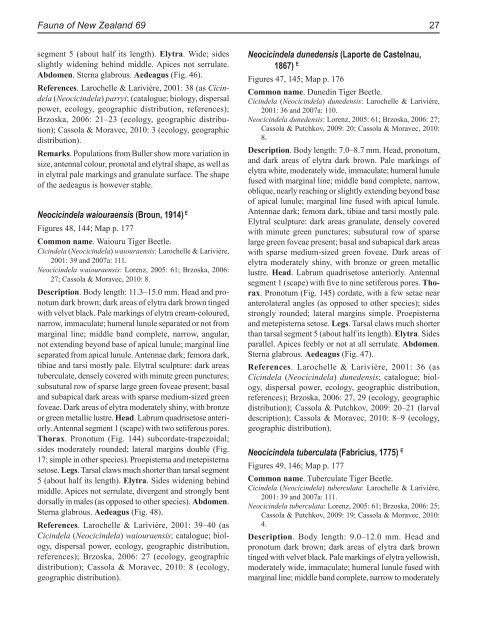Fauna of New Zealand 69 - Landcare Research
Fauna of New Zealand 69 - Landcare Research
Fauna of New Zealand 69 - Landcare Research
Create successful ePaper yourself
Turn your PDF publications into a flip-book with our unique Google optimized e-Paper software.
<strong>Fauna</strong> <strong>of</strong> <strong>New</strong> <strong>Zealand</strong> <strong>69</strong> 27<br />
segment 5 (about half its length). Elytra. Wide; sides<br />
slightly widening behind middle. Apices not serrulate.<br />
Abdomen. Sterna glabrous. Aedeagus (Fig. 46).<br />
References. Larochelle & Larivière, 2001: 38 (as Cicindela<br />
(Neocicindela) parryi; (catalogue; biology, dispersal<br />
power, ecology, geographic distribution, references);<br />
Brzoska, 2006: 21–23 (ecology, geographic distribution);<br />
Cassola & Moravec, 2010: 3 (ecology, geographic<br />
distribution).<br />
Remarks. Populations from Buller show more variation in<br />
size, antennal colour, pronotal and elytral shape, as well as<br />
in elytral pale markings and granulate surface. The shape<br />
<strong>of</strong> the aedeagus is however stable.<br />
Neocicindela waiouraensis (Broun, 1914) E<br />
Figures 48, 144; Map p. 177<br />
Common name. Waiouru Tiger Beetle.<br />
Cicindela (Neocicindela) waiouraensis: Larochelle & Larivière,<br />
2001: 39 and 2007a: 111.<br />
Neocicindela waiouraensis: Lorenz, 2005: 61; Brzoska, 2006:<br />
27; Cassola & Moravec, 2010: 8.<br />
Description. Body length: 11.3–15.0 mm. Head and pronotum<br />
dark brown; dark areas <strong>of</strong> elytra dark brown tinged<br />
with velvet black. Pale markings <strong>of</strong> elytra cream-coloured,<br />
narrow, immaculate; humeral lunule separated or not from<br />
marginal line; middle band complete, narrow, angular,<br />
not extending beyond base <strong>of</strong> apical lunule; marginal line<br />
separated from apical lunule. Antennae dark; femora dark,<br />
tibiae and tarsi mostly pale. Elytral sculpture: dark areas<br />
tuberculate, densely covered with minute green punctures;<br />
subsutural row <strong>of</strong> sparse large green foveae present; basal<br />
and subapical dark areas with sparse medium-sized green<br />
foveae. Dark areas <strong>of</strong> elytra moderately shiny, with bronze<br />
or green metallic lustre. Head. Labrum quadrisetose anteriorly.<br />
Antennal segment 1 (scape) with two setiferous pores.<br />
Thorax. Pronotum (Fig. 144) subcordate-trapezoidal;<br />
sides moderately rounded; lateral margins double (Fig.<br />
17; simple in other species). Proepisterna and metepisterna<br />
setose. Legs. Tarsal claws much shorter than tarsal segment<br />
5 (about half its length). Elytra. Sides widening behind<br />
middle. Apices not serrulate, divergent and strongly bent<br />
dorsally in males (as opposed to other species). Abdomen.<br />
Sterna glabrous. Aedeagus (Fig. 48).<br />
References. Larochelle & Larivière, 2001: 39–40 (as<br />
Cicindela (Neocicindela) waiouraensis; catalogue; biology,<br />
dispersal power, ecology, geographic distribution,<br />
references); Brzoska, 2006: 27 (ecology, geographic<br />
distribution); Cassola & Moravec, 2010: 8 (ecology,<br />
geographic distribution).<br />
Neocicindela dunedensis (Laporte de Castelnau,<br />
1867) E<br />
Figures 47, 145; Map p. 176<br />
Common name. Dunedin Tiger Beetle.<br />
Cicindela (Neocicindela) dunedensis: Larochelle & Larivière,<br />
2001: 36 and 2007a: 110.<br />
Neocicindela dunedensis: Lorenz, 2005: 61; Brzoska, 2006: 27;<br />
Cassola & Putchkov, 2009: 20; Cassola & Moravec, 2010:<br />
8.<br />
Description. Body length: 7.0–8.7 mm. Head, pronotum,<br />
and dark areas <strong>of</strong> elytra dark brown. Pale markings <strong>of</strong><br />
elytra white, moderately wide, immaculate; humeral lunule<br />
fused with marginal line; middle band complete, narrow,<br />
oblique, nearly reaching or slightly extending beyond base<br />
<strong>of</strong> apical lunule; marginal line fused with apical lunule.<br />
Antennae dark; femora dark, tibiae and tarsi mostly pale.<br />
Elytral sculpture: dark areas granulate, densely covered<br />
with minute green punctures; subsutural row <strong>of</strong> sparse<br />
large green foveae present; basal and subapical dark areas<br />
with sparse medium-sized green foveae. Dark areas <strong>of</strong><br />
elytra moderately shiny, with bronze or green metallic<br />
lustre. Head. Labrum quadrisetose anteriorly. Antennal<br />
segment 1 (scape) with five to nine setiferous pores. Thorax.<br />
Pronotum (Fig. 145) cordate, with a few setae near<br />
anterolateral angles (as opposed to other species); sides<br />
strongly rounded; lateral margins simple. Proepisterna<br />
and metepisterna setose. Legs. Tarsal claws much shorter<br />
than tarsal segment 5 (about half its length). Elytra. Sides<br />
parallel. Apices feebly or not at all serrulate. Abdomen.<br />
Sterna glabrous. Aedeagus (Fig. 47).<br />
References. Larochelle & Larivière, 2001: 36 (as<br />
Cicindela (Neocicindela) dunedensis; catalogue; biology,<br />
dispersal power, ecology, geographic distribution,<br />
references); Brzoska, 2006: 27, 29 (ecology, geographic<br />
distribution); Cassola & Putchkov, 2009: 20–21 (larval<br />
description); Cassola & Moravec, 2010: 8–9 (ecology,<br />
geographic distribution).<br />
Neocicindela tuberculata (Fabricius, 1775) E<br />
Figures 49, 146; Map p. 177<br />
Common name. Tuberculate Tiger Beetle.<br />
Cicindela (Neocicindela) tuberculata: Larochelle & Larivière,<br />
2001: 39 and 2007a: 111.<br />
Neocicindela tuberculata: Lorenz, 2005: 61; Brzoska, 2006: 25;<br />
Cassola & Putchkov, 2009: 19; Cassola & Moravec, 2010:<br />
4.<br />
Description. Body length: 9.0–12.0 mm. Head and<br />
pronotum dark brown; dark areas <strong>of</strong> elytra dark brown<br />
tinged with velvet black. Pale markings <strong>of</strong> elytra yellowish,<br />
moderately wide, immaculate; humeral lunule fused with<br />
marginal line; middle band complete, narrow to moderately
















